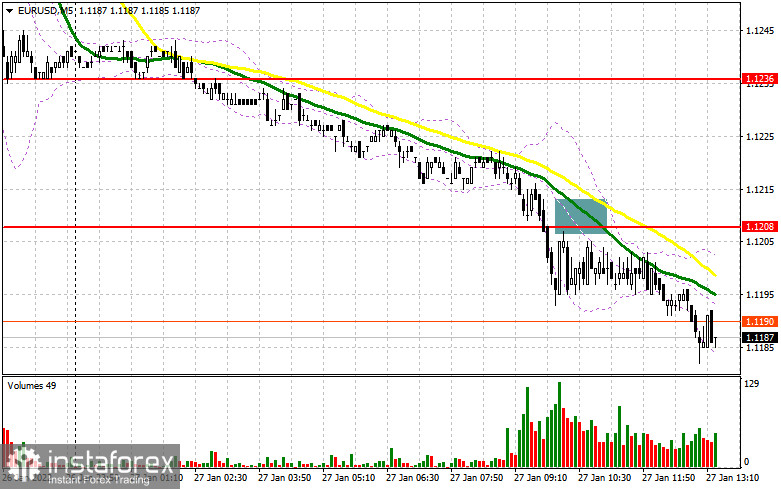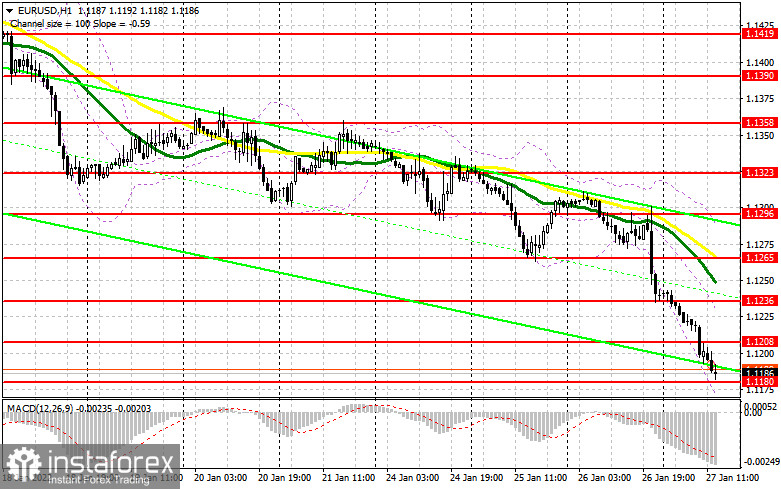To open long positions on EURUSD, you need:
In my morning forecast, I paid attention to the 1.1208 level and recommended that decisions on entering the market be made from it. Let's look at the 5-minute chart and figure out what happened. The lack of activity on the part of euro buyers after yesterday's meeting of the Federal Reserve System led to an instant breakdown and consolidation below 1.1208. The reverse test from the bottom up, which I paid attention to in the morning, formed a sell signal further along with the trend, as a result of which the pair fell to the critical support of 1.1180, below which the euro will have even more problems. And what were the entry points for the pound this morning?

In the afternoon, the focus will shift to a very important report on the US economy, which may lead to an even greater decline in EUR/USD and a fall below 1.1180. Let me remind you that during yesterday's meeting of the Federal Reserve System, decisions were made to raise interest rates in the United States in March this year, which returned demand for the dollar and led to a fall in risky assets.
Now the bulls need to try very hard to regain the location of the market, but judging by how everyone is hiding around the 1.1180 level, it will be very problematic to do this. If in the near future we do not see a return above 1.1208, which we missed in the first half of the day - the euro will continue to fall. In this case, the primary task of buyers will be to protect the support of 1.1180, the test of which will be the last hope of the bulls for a market reversal. The formation of a false breakdown at the level of 1.1180 forms a signal to buy the euro, but a larger upward correction will occur only in the case of poor data on US GDP for the 4th quarter of this year and the number of initial applications for unemployment benefits.
The return of the 1.1208 level remains an equally important task for buyers. Consolidation above this range will lead to a signal to buy EUR/USD, which will open up the possibility of recovery to the area of 1.1236. A longer-range target will be a maximum of 1.1265, where the moving averages are playing on the sellers' side. I recommend fixing profits there. With the pair declining during the American session and the absence of bull activity at 1.1180, and everything is heading for a breakdown of this level, the pressure on the euro may seriously increase. In this case, it is better not to try to find the bottom or catch a rebound. I advise you to postpone purchases to a new low of 1.1155. However, I advise you to open long positions there when forming a false breakdown. From the levels of 1.1118 and 1.1081, you can buy EUR/USD immediately for a rebound with the aim of an upward correction of 20-25 points within the day.
To open short positions on EURUSD, you need:
Sellers continue to control the market, and the breakthrough of the next support of 1.1208 in the morning only proves this. The absence of buyers below the base of the 12th figure has a very bad effect on bull sentiment, which can lead to a more protracted downward trend. As I noted above, the entire focus will be on US data.

While trading will be conducted below the range of 1.1208, we can expect a fall to a minimum of 1.1180. The breakdown and test of this area from the bottom up, together with strong data on the US economy - GDP should be much better than economists' forecasts - all this will give an additional signal to open short positions with the prospect of reaching 1.1155 and 1.1118. A more distant target will be the 1.1081 area, where I recommend fixing the profits. However, this level will be reached only in the event of a panic sale of risky assets due to news of a breakthrough in the American economy at the end of last year.
If the euro rises during the American session, the bears will need to think about how to defend the resistance of 1.1208. The formation of a false breakdown at this level forms an additional point for short positions. You can sell EUR/USD immediately for a rebound from 1.1236, or even higher - around 1.1265 with the aim of a downward correction of 15-20 points.
The COT report (Commitment of Traders) for January 18 recorded an increase in long positions and a reduction in short ones, which led to a further increase in the positive delta. This suggests that even despite the expected changes in the policy of the Federal Reserve System, the demand for the euro has not gone away. The more correction occurs in the EUR/USD pair, the stronger the demand. This week, everyone is waiting for the results of the meeting of the open market committee, at which a decision on monetary policy will be made. Some traders expect that the central bank may decide to raise interest rates already during the January meeting, without postponing this issue until March. A reduction in the Fed's balance sheet will also be announced. A lot depends on the rhetoric of Federal Reserve Chairman Jerome Powell. If he expresses concern about inflation in the US, most likely the demand for the US dollar will only increase. Currently, four interest rate hikes in the US are already predicted this year, and some major players are talking about five. Meanwhile, the European Central Bank plans to fully complete its emergency bond purchase program in March this year. However, the regulator is not going to take any other actions aimed at tightening its policy, which limits the upward potential of risky assets. The COT report indicates that long non-profit positions rose from the level of 204,361 to the level of 211,901, while short non-profit positions fell from the level of 198,356 to 187,317. This suggests that traders continue to increase long positions in the euro with the expectation of building an upward trend. At the end of the week, the total non-commercial net position remained positive and amounted to 24,584 against 6,005. The weekly closing price rose to 1.1410 against 1.1330 a week earlier.
Signals of indicators:
Moving averages
Trading is conducted below 30 and 50 daily moving averages, which indicates that the market remains under the control of sellers.
Note: The period and prices of moving averages are considered by the author on the hourly chart H1 and differ from the general definition of the classic daily moving averages on the daily chart D1.
Bollinger Bands
In the case of growth, the average border of the indicator in the area of 1.1236 will act as resistance.
Description of indicators
- Moving average (moving average determines the current trend by smoothing out volatility and noise). Period 50. The graph is marked in yellow.
- Moving average (moving average determines the current trend by smoothing out volatility and noise). Period 30. The graph is marked in green.
- MACD indicator (Moving Average Convergence / Divergence - moving average convergence/divergence) Fast EMA period 12. Slow EMA period 26. SMA period 9
- Bollinger Bands (Bollinger Bands). Period 20
- Non-profit speculative traders, such as individual traders, hedge funds, and large institutions that use the futures market for speculative purposes and meet certain requirements.
- Long non-commercial positions represent the total long open position of non-commercial traders.
- Short non-commercial positions represent the total short open position of non-commercial traders.
- Total non-commercial net position is the difference between the short and long positions of non-commercial traders.
 English
English 
 Русский
Русский Bahasa Indonesia
Bahasa Indonesia Bahasa Malay
Bahasa Malay ไทย
ไทย Español
Español Deutsch
Deutsch Български
Български Français
Français Tiếng Việt
Tiếng Việt 中文
中文 বাংলা
বাংলা हिन्दी
हिन्दी Čeština
Čeština Українська
Українська Română
Română

